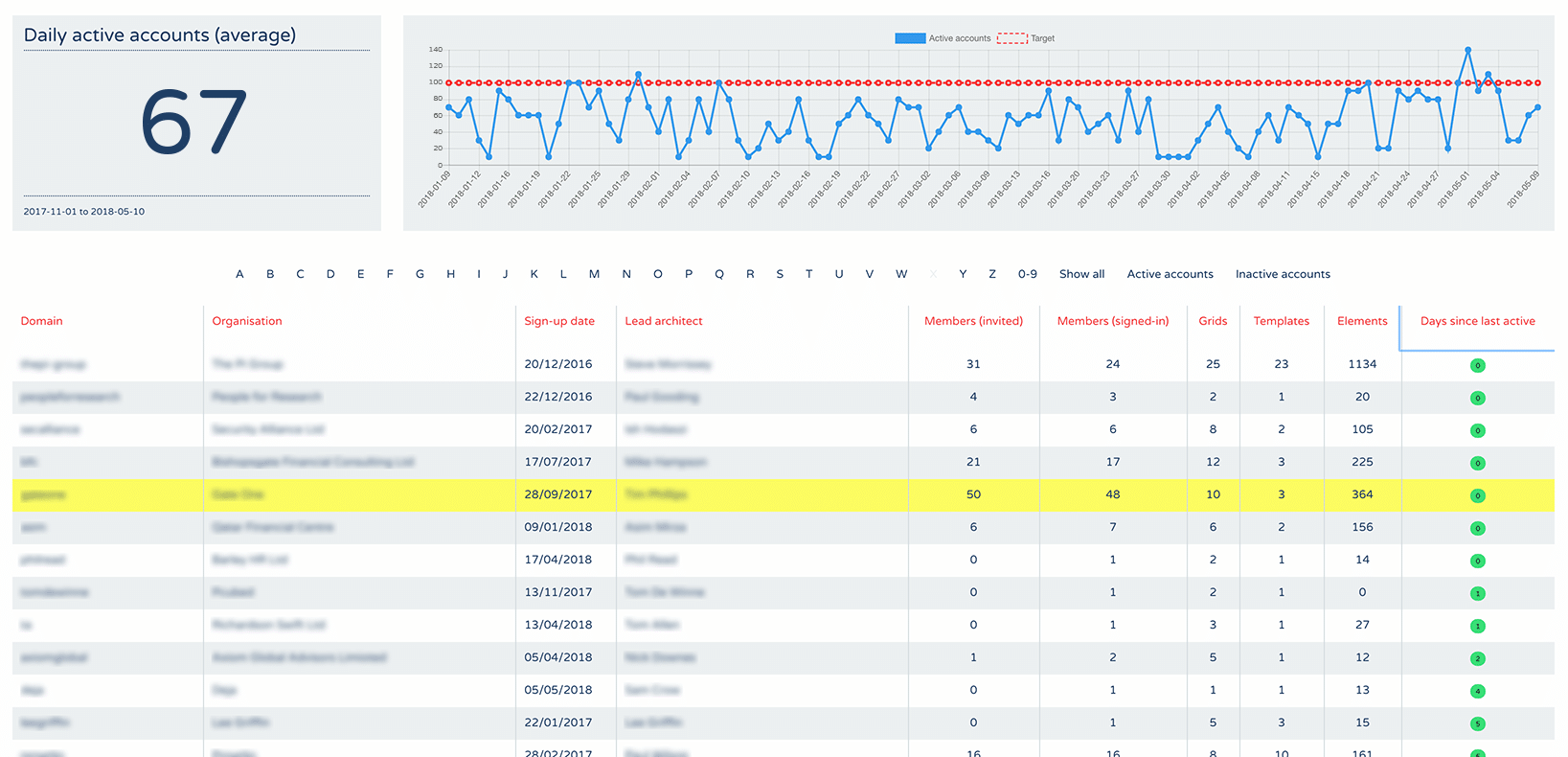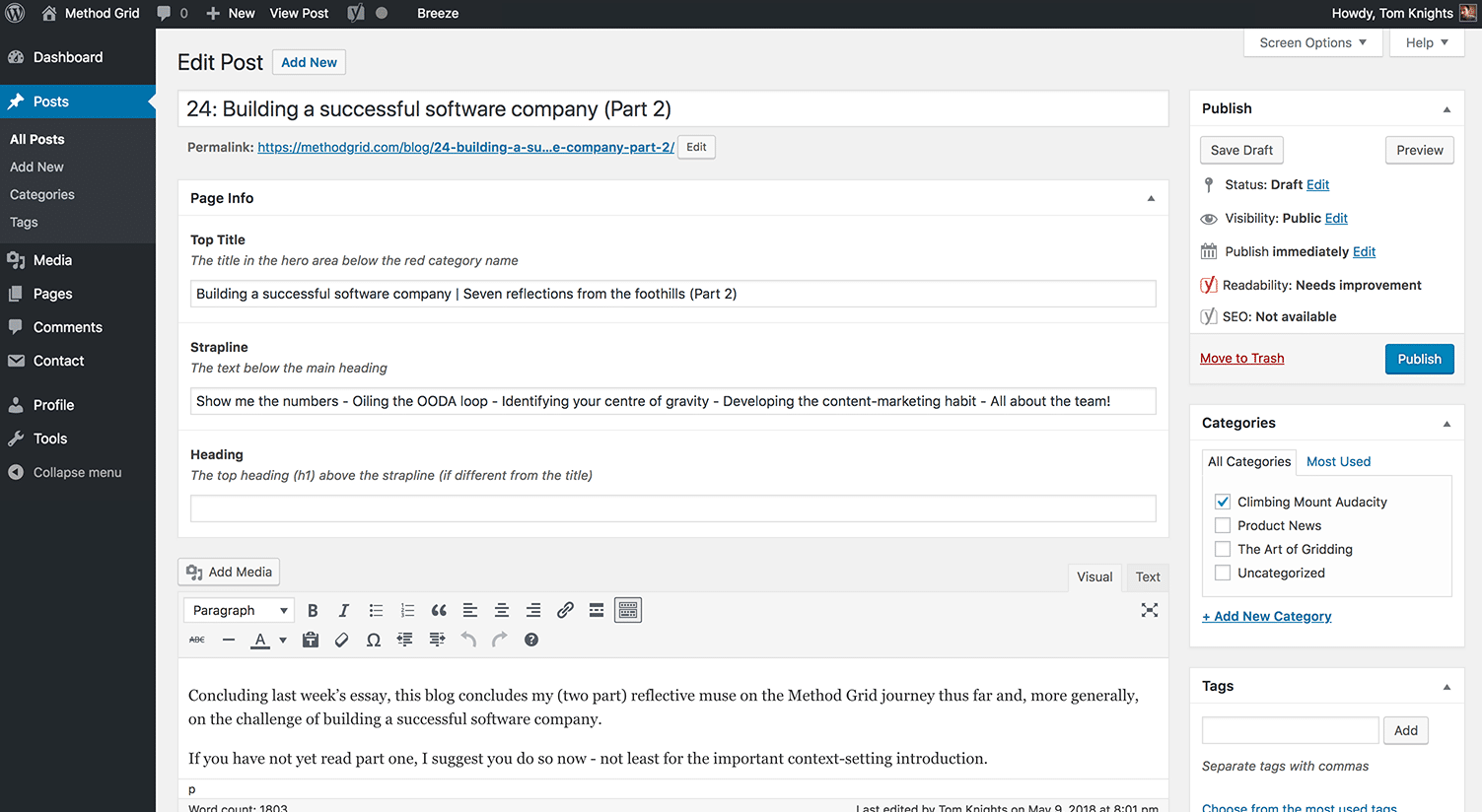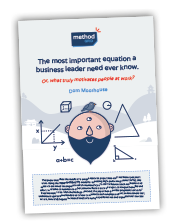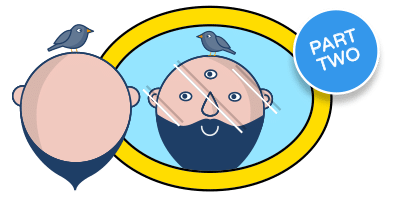Show me the numbers - Oiling the OODA loop - Identifying your centre of gravity - Developing the content-marketing habit - All about the team!
Concluding last week’s essay, this blog concludes my (two part) reflective muse on the Method Grid journey thus far and, more generally, on the challenge of building a successful software company.
If you have not yet read part one, I suggest you do so now – not least for the important context-setting introduction.
Otherwise, let’s continue.
Reflection 04: Show me the numbers!
At its simplest first principle, building a company involves making the right decisions, at the right time, armed with the right data.
Advising the boards and leaders of professional service companies over the years, I find that a hefty component of time and focus falls on this topic. You can only successfully grow a business if you, firstly, truly understand the (very few) key performance indicators (KPIs) that really matter. Armed with such knowledge, success lies in assiduously and regularly observing such data in order that a management team can continuously orientate themselves. By orientate, I mean draw intelligent inference between the current behaviours, actions and capabilities of your team and these results. If there is a variance between actual results and expected/planned results, then this should trigger rational discussion as to how this variance is addressed. Ultimately, this performance management cycle should drive decisions that can be quickly acted upon – new initiatives, enhanced systems, improved behaviours to drive the business forward. In a competitive market, companies that rise to the top are those that drive this observe-orientate-decide-act (OODA) loop with greater tempo and efficacy than their competitors.
Whilst I am personally very familiar with the KPIs of successful professional service companies, the software build and marketing journey requires a whole new lexicon; by example: landing page conversion and trial-to-signup conversion rates, cost per acquisition, customer retention/churn etc.
Whilst metrics are always very contingent to the sector in which you play, a commonality that the successful share is an obsession with data presentation. As Edward Tufte*, a lead proponent in this growing field states:
“Graphical excellence is that which gives to the viewer the greatest number of ideas in the shortest time with the least ink in the smallest space.”
What Tufte articulates matches a very close behaviour-to-results correlation I have observed in professional service leadership teams over the years. That is, the most successful invariably have a mild-obsession with management information (MI) dashboards – continuously improving data veracity, data set selection (focusing on a few measures cf. getting lost in the weeds of a multiple page report) and data/trend graphical presentation (quickly triaging the focus of time-poor executives to the places where decisions are required).
Whilst we have certainly not got this right yet for Method Grid, what has hugely helped us get this far is a similar obsession with our dashboard – “do we have the right metrics?, what are they telling us?, what do we need to change as a result of what we are seeing?”.
Early on, we realised that without such a dashboard we were really flying blind with respect to how our beta application was being used, what type of user journeys were unfolding, how we could improve the sign-up and on-boarding experience etc. As such, a significant component of our development time has been allotted to the development of this internal view.

My reflection is not that we have got this completely right (much work still to be done!); rather that we could have only got this far with: (a) the committed investment to building this portal, (b) an obsession as to how our KPIs are optimally presented/graphed and (c) the regular (for us, twice weekly) discipline of gathering around it – to oil our own OODA loop.
Reflection 05: Identify your marketing “centre of gravity”
Since our public beta trial launched (November 2017) we now have over 200 beta account users. We have been delighted by the range of organisations – from multiple sectors – using and enjoying the software. Whilst this has opened our eyes to the broad applicability of Method Grid we know that, with respect to our marketing efforts, we go too broad, too early at our peril.
This early success – we believe – emanates from a deliberate focus on our starting point hypothesis and core segment focus: professional service companies. Since launching the beta trial, I have been producing a weekly blog that talks primarily to this reader: business leaders within professional service firms.
There is an inevitable seduction to scatter the seeds wider; we hope, in the fullness of time, to do so – but only once some very significant commercial foundations are laid within our “centre of gravity”. Distraction and peripheral vision are the enemies of first, stable footholds.
Supportive marketing experts in our professional networks have kept us honest to this mantra and I wholeheartedly thank them for it. My reflection here is to simply encourage other early-stage software builds to do similar.
Ask yourself: can you more tightly delineate your target user and market to deliver more focused relevance (both in terms of your application and any content marketing value-add)? If so, do so – as this will invariably support you in building a critical set of early advocates. Only then, do we have permission to look outwards.
Reflection 06: Content marketing – developing the habit.
We have a long way to go with this!
I am certainly not going to claim any exaggerated results in this area yet. Admittedly, a blog focused on professional service leaders is playing to a niche crowd (maybe too late to pivot towards an app for pet-owners!?); notwithstanding, we still have much to learn here. Especially so with respect to linking with other key influencers in this space and amplifying our (growing) library of content.
That all said, we have to date not spent a single penny on marketing. Rather, our beta community has grown solely on personal network, word of mouth and this metronomic content-marketing strategy.
Per Reflection 05, the content marketing is focused. The core blog series is titled Climbing Mount Audacity with the strap: We’re sharing everything we know about how to build an awesome professional service firm (and enjoy the journey en route!) PLUS travel updates, reflections on our stumbles and general musings on our Method Grid journey.
We set out – from the start of the public beta phase – to produce a post each week. Thus far, some six months in, we have kept to this tempo. As anyone who has committed to a regular blog knows this is hard work but – and this is the core reflection – it pays back. Every week, the numbers of unique website visitors and opt ins to our newsletter grows. Indeed, a number of these blogs are already attracting a healthy degree of organic readership; a number are Google page one for the specific search terms they address. So, the key message here is to build the content marketing habit and really stick with it. Clearly, the more you can drive up your organic (SEO) content relevance, the lower your future cost of acquisition will be.

By way of technical aside, let me share how we go about this. Like most aspects, it is a real team discipline. Via key collaboration tools we task manage each blog from concept to draft to publication (we initially used Trello for this but now use Method Grid). I lead on the idea generation and copywriting (Google Docs), Tom then uploads my draft to WordPress adding the branded graphics (using Adobe Creative Suite: Indesign, Illustrator and Photoshop), I then return for final edit and SEO refinement (with the SEO-expertise of Jody on my shoulder). On average, each blog takes c. 2-4 hours to draft, c. 1-2 hours to design and c. 1 hour to refine/edit/publish. Once published on the website, we then systematically work through our amplification checklist consisting of rebroadcast on: LinkedIn, Newsletter (Campaign Monitor), Twitter and Facebook. This adds another c. 1 hour to the process.
Reflection 07: It’s all about the team!
The experience of guiding Method Grid out of the foothills has further reinforced in my mind the immutable truth that all businesses live-or-die fundamentally on the quality of the team brought to bear on the plan. As I have oft pronounced, when all is said and done, business success is about execution, execution, execution and execution is all about high-performing teams.
As per the fascinating research conducted last year (see paper download below), high performing teams (using the Team-to-Tribe model) are well selected (for a “can do, can do” attitude), know what to do (clear plan), are allowed to do (limited formality) and have strong values alignment, passion for the task and an experience-forged, collective-sense of “together, anything is possible”.
Please send me
The most important equation a business leader need ever know
Or, what truly motivates people at work?

The founding four of us have worked brilliantly together – both with respect to the technical complementarity of our respective skill sets but also as a function of pre-established working trust (having worked together on previous projects). As a side note, these previous projects had fine-tuned our collaborative practices – working from different locations. Regular and intense (2-3 day) face-to-face summits set the scene for the next strategic bound and, thereafter, a honed suite of cloud tools facilitate task management and communication: Google Drive/Chat/Hangouts/Calendar, Trello and, of course, Method Grid!
As it is potentially instructive to others, the respective skills jigsaw was: myself (commercial oversight, product concept, business development), Ian (back end development ops, data security), Tom (UX design, brand architect, graphic design) and Jody (front end development, user support, digital strategy).
At the heart of this reflection – for founders just setting out – is the message that your team selection/recruitment really is the fateful starting point. Brilliant teams can pivot-rescue mediocre software ideas, mediocre teams can murder a brilliant software concept.
Finally, I should also say that regardless of where Method Grid ultimately goes, it has been a real joy (and rewarding professional development experience) working with Jody, Tom and Ian on this project in recent years. Perhaps that is the most fitting final reflection as we stare up at the towering, heavily-crevassed pinnacle ahead: whilst the end goal matters so too does the enjoyed, shared companionship en route. So choose carefully!
Regardless of where you are on this metaphorical path, travel well.
* Other leading proponents who I heartily recommend when it comes to the visual presentation of quantitative information: Stephen Few and David McCandless.
So, what’s next?
Next week, I return to my focus on selling and how to build a professional services sales capability with a look at how to win and develop (carefully targeted) new accounts.
Hopefully, you’ll join us on this journey. It’s totally free, and you don’t have to be a Method Grid customer (though you’re more than welcome to sign up for a free trial here).
We’ll be releasing a new post each week. To get each post emailed to you as soon as it’s published, sign up for the Climbing Mount Audacity mailing list below.
Climbing Mount Audacity…
From Startup to Scaleup!
We're sharing everything we know about how to build an awesome professional service firm (and enjoy the journey en route!) PLUS travel updates, reflections on our stumbles and general musings on our Method Grid journey.
Signup below to get the latest articles
direct to your inbox.
See you next week. Have something you want to hear more about? Let me know in the comments below or via Twitter.

 Project and Program Management
Project and Program Management  Project Governance Framework
Project Governance Framework  Benefits Management Framework
Benefits Management Framework 






